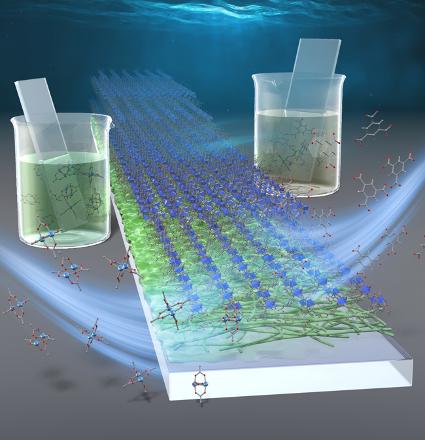Coating plastics by porous nanofilm

Image picture of the fabrication method reported in this study
Credit: Tohoku University
A research team has developed a new method for creating metal-organic framework (MOF) thin films that can be applied to sensors and electric devices.
Like sponges, porous materials contain pores. The pore size affects the property of the material. For example, small pores create more absorbent surface areas. Silica gel, which is often used in food packaging to soak up moisture, is one typical example.
Recent studies on porous materials have led to the development of new materials with designable pores, affording scientists with greater control over the properties of such materials.
MOF is a porous material made up of metal ions coordinated by organic linking molecules. Well-ordered nanopores in MOFs have potential applications in material science and pharmacology.
Despite a growing interest in MOFs, researchers have yet to establish an effective method for forming MOF into thin films. Most studies on MOF preparation focus exclusively on the powdered form. Forming MOF into thin films opens up its use for humidity sensing, gas sensing and resistive switching devices.
Researchers from Tohoku University, Iwate University and the Japan Synchrotron Radiation Research Institute (JASRI) overcame this obstacle by controlling the growth of MOF into films. This involved a simple “layer-by-layer” method, which uses sequential immersing of substrates into ingredient solutions.
The research group chose four types of commonly used plastic materials as a substrate for MOF film growth. They cultivated the growth of MOF films on plastic materials such as nylon and acrylic resin.
“The facile and versatile fabrication techniques used in this study have opened up MOFs to new application fields such as sensors and memory devices,” said Shunsuke Yamamoto, co-author of the study. “We hope our research serves as the starting point for using MOF films with electronic devices.”
Further studies on the film growing mechanism are expected to provide important insights into the coating on flexible and transparent plastic substrates under ambient conditions.
All latest news from the category: Materials Sciences
Materials management deals with the research, development, manufacturing and processing of raw and industrial materials. Key aspects here are biological and medical issues, which play an increasingly important role in this field.
innovations-report offers in-depth articles related to the development and application of materials and the structure and properties of new materials.
Newest articles

NASA: Mystery of life’s handedness deepens
The mystery of why life uses molecules with specific orientations has deepened with a NASA-funded discovery that RNA — a key molecule thought to have potentially held the instructions for…

What are the effects of historic lithium mining on water quality?
Study reveals low levels of common contaminants but high levels of other elements in waters associated with an abandoned lithium mine. Lithium ore and mining waste from a historic lithium…

Quantum-inspired design boosts efficiency of heat-to-electricity conversion
Rice engineers take unconventional route to improving thermophotovoltaic systems. Researchers at Rice University have found a new way to improve a key element of thermophotovoltaic (TPV) systems, which convert heat…



